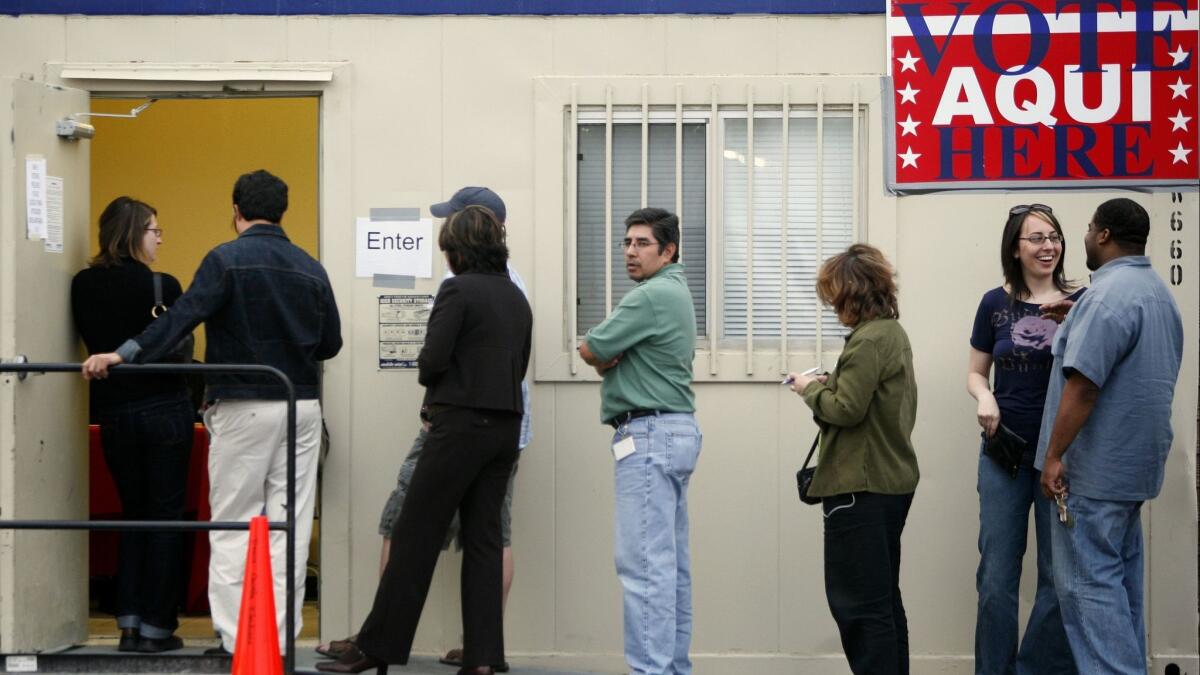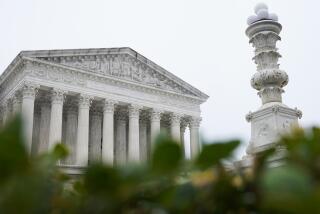Editorial: American voters don’t need a dress code

Should voters have to abide by a dress code? The idea seems absurd. Yet when Andrew Cilek showed up to cast his ballot in Hennepin County, Minn., in 2010, he was asked to remove or cover up a Tea Party shirt and a button reading “Please ID Me” (a message promoting a controversial step by poll workers — demanding identification from would-be voters — as a way to guard against election fraud).
Cilek eventually was allowed to vote without removing the offending shirt and button. But last week his lawyer asked the Supreme Court to strike down the state law that brought his apparel under the scrutiny of election officials. It prohibits the wearing of a “political badge, political button, or other political insignia” at a polling place on election day.
Workers at polling places shouldn’t be critiquing either the fashion choices or the opinions of voters.
The court should do so because the law is a violation of the 1st Amendment; the only issue is how broad the ruling should be.
Wednesday’s oral argument validated the main contention raised by Cilek and the Minnesota Voters Alliance: that the law is unconstitutionally over-broad because it suppresses speech far beyond advocacy for a party or candidate. Even worse, the state seems to have arbitrary standards for deciding which political messages fall on the permissible side of the line.
In a revealing exchange with Justice Samuel A. Alito, Daniel Rogan, the lawyer defending the law, suggested that a shirt bearing the slogan “Parkland Strong” (a reference to the site of the recent Florida school shooting) would be permissible, but not a shirt showing the logo of the National Rifle Assn. Likewise, Rogan said, a shirt displaying the text of the 1st Amendment would be acceptable, but one displaying the text of the 2nd Amendment “could be viewed as political.”
Justice Neil Gorsuch worried that the state’s approach “would forbid people from wearing certain portions of the Bill of Rights into a polling place but not other portions of the Bill of Rights.” That worries us too. What constitutes an unacceptably political message on a piece of clothing is inherently a subjective judgment that government officials ought not to be making.
Minnesota goes further than many other states in regulating expression at polling places. California, for example, bans only shirts with messages that engage in “electioneering” — defined as “information that advocates for or against any candidate or measure on the ballot.”
In 1992 the Supreme Court upheld a Tennessee law that prohibited the solicitation of votes or the display or distribution of campaign materials within 100 feet of a polling place. Justice Harry Blackmun wrote that the burden the law imposed on free speech was justified by the compelling interest of preventing voter intimidation and election fraud. The court could strike down Minnesota’s broad law without disturbing that decision.
We believe, though, that the court should go further. A better line to draw would prohibit active electioneering at a polling place — by accosting or intimidating other voters, say, or handing out literature — while allowing the silent advocacy of a shirt bearing a political message (even “Vote for Candidate X”) or a political button.
That approach not only would show a greater respect for free speech; it also would recognize that voters are increasingly casting ballots by mail or dropping them off at early-voting centers, making the concerns about political messaging at polling places less meaningful. If an organized group of voters used messages on clothing or buttons to try to intimidate other voters who continue to vote at public polling places — a scenario raised by the state of Minnesota — that could be addressed by election officials.
Some justices at Wednesday’s arguments suggested that restricting political expression by voters — even in the silent form of an article of clothing — might be justified in the absence of intimidation. Chief Justice John G. Roberts Jr. asked why a state couldn’t decide that “maybe, just before you cast your vote, you should be able to have a time for some quiet reflection . . . without being bombarded by another campaign display.”
But maintaining what Justice Elena Kagan sarcastically called a “church-like” atmosphere at polling place shouldn’t be the principal priority of election officials. Certainly it isn’t a reason to suppress silent, nondisruptive expression.
Ideally the court will rule broadly in this case. But at a minimum it must strike down Minnesota’s law. Workers at polling places shouldn’t be critiquing either the fashion choices or the opinions of voters.
Follow the Opinion section on Twitter @latimesopinionand Facebook
More to Read
A cure for the common opinion
Get thought-provoking perspectives with our weekly newsletter.
You may occasionally receive promotional content from the Los Angeles Times.










